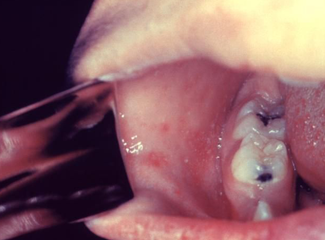Measles 2011: The Latest Import From Europe
The first 5 months of 2011 have seen the highest number of measles cases in this country in almost a decade.
The first 5 months of 2011 have seen the highest number of measles cases in this country in almost a decade. Many cases are being imported from abroad. As one official put it, patients with measles are “only a plane ride away” from your waiting room.
The virus that causes this highly contagious infection (Figures 1 and 2) can lead to serious complications-including encephalitis, severe measles pneumonia, and even death.1 According to the CDC, only as recently as the late 1990s did active vaccination programs halt endemic transmission of measles in the United States. The balance of the Americas have seen less than a decade without the threat of severe outbreaks.1 Now, like the mumps-another nearly eradicated, vaccine-preventable disease-measles is making a comeback.1,2 The virus continues to thrive in Europe and South-East Asia and so the risk of importation remains a threat to all. The antidote is continued widespread MMR vaccination-in 2 doses-and primary care physicians are the front line of defense.
Figure 1

Figure 2

During the first 19 weeks of 2011, 118 cases of measles were reported-the highest number reported for that period since 1996.1 In comparison, during 2001 to 2008 a median of 56 (range, 37-140) cases annually were reported to the CDC.2 Of the 118 cases reported during January 1 to May 20, 2011, 105 (89%) were described as “importation-associated.”1 Confirmed importations accounted for 46 cases-34 US residents returning from travel abroad and 12 among foreign visitors to the US. Age spanned a wide range (3 months to 69 years): roughly one-third of those affected were children 4 years of age and younger.1
Of the 118 measles cases, 105 (89%) patients were unvaccinated. The reasons for not having received the MMR vaccine included religious/personal exemption, missed opportunities for vaccination, and philosophical objections to vaccination.1 Broad public health awareness campaigns on the dangers of eschewing vaccination have not changed attitudes among those who object to vaccination. Unfortunately, those who choose to forego vaccination place the greater community at risk. The CDC warns that even a small decrease in the rates of MMR vaccination coverage poses the greatest threat to sustaining measles elimination. The virus is highly infectious: measles develops in up to 90% of susceptible persons after exposure.1
The CDC recommends that you consider measles in a person who presents with fever and rash and other compatible symptoms (eg, cough, coryza, and/or conjunctivitis) and who has recently traveled abroad or who has had contact with travelers. Before international travel, infants aged 6 to 11 months should receive 1 does of MMR vaccine.1 Anyone age 1 year or older should receive 2 doses of MMR vaccine at least 28 days apart or be able to provide evidence of immunity.1 The recent “rash” of cases was imported from at least 15 countries. France has reported the largest recent outbreak (with 10,000 cases from January to April). However, 33 other countries in the World Health Organization European Region have reported an increase in measles cases this year.
The MMR vaccine is recommended routinely for all children at age 12 to 15 months, followed by a second dose at age 4 to 6 years. A single dose of MMR vaccine is recommended for adults who cannot prove immunity to measles. Two doses are recommended for adults at high-risk: these include health care personnel, international travelers, and students who live in dormitories.1 Details can be found at the CDC’s web site.
More than ever, primary care physicians need to focus their daily education and prevention efforts on the individuals who need to be vaccinated.
Figure 1: Koplik spots are a prodromic viral rash that appears on the buccal mucosa of an infected individual and are diagnostic of measles. They are generally seen only on he first day of the rash.
Figure 2: Symptoms of measles include fever, cough, runny nose, red eyes and a generalized, maculopapular, erythematous rash. This is the skin of a patient after 3 days of measles infection.
References:
References:
1. Centers for Disease Control and Prevention (CDC). Update: measles-United States, January-May 20, 2011. MMWR. 2011;60:666-668.
2. Parker Feibelkorn A, Redd SB, Gallagher K, et al. Measles in the United States during the postelimination era. J Infect Dis. 2010;202:1520-1528.